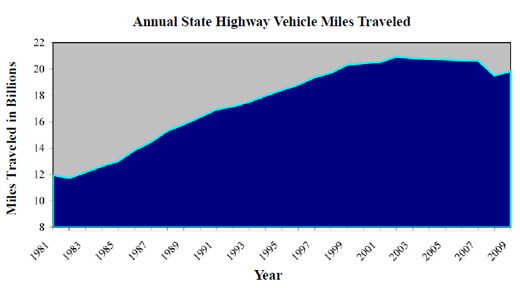I think you can officially call this a pattern: traffic volumes all around the Pacific Northwest are falling short of the projections made just a few years ago. Take a look at just a sampling of the evidence:
- The Golden Ears Bridge: Both traffic volumes and tolling revenue on this new bridge outside of Vancouver, BC are falling short of expectations, adding up to “a cumulative shortfall of $63.8 million since 2009 for a bridge that was supposed to pay itself off in 30 years,” according to the Maple Ridge Times.
- The Columbia River Crossing project: According to this analysis by Portland economist Joe Cortright, the number of cars taking the I-5 bridge between Portland, OR and Vancouver, WA “has declined every year after 2005.” The trends are almost the exact opposite of the transportation modelers’ predictions: “Traffic levels in the nearly five years since CRC forecasts were completed have declined by about 7,000 vehicles per day, rather than increasing by about 7,000 vehicles per day as forecast.”
- Seattle: According to a recent Seattle Times story, “the Seattle Department of Transportation…found traffic dropping from 920,000 average daily trips within city limits for 2008 (and 975,000 trips in 2003) to 900,000 trips in 2009.” This is roughly the same story we heard last year (see Publicola for news coverage, and the SDOT website for traffic maps). Of course, the numbers are a bit old now, and may be tied up in the effects of the recession.
- Portland: In greater Portland, OR, vehicle travel measured per person peaked in 1996, and has fallen by about 12 percent since then.
- Washington highways: From 1983 through 2000, total vehicle travel in the state had typically increased in the range of 2.5 to 6.5 percent per year—i.e., a lot. But after 2000, vehicle travel started growing much more slowly; and then it cratered in 2008, when gas prices soared and the economy soured. As a result, traffic volumes on state highways were lower in 2009 than in 2002. (See p. 47 of this pdf from WSDOT—but note that a change in methods may have affected the reported traffic between 2003 and 2004.)
- Oregon highway system: In Oregon, traffic volumes—not just per person, but total miles logged on highways—peaked in 2002. VMTs fell slightly from 2002 through 2007, and then fell sharply in 2008. (See the chart below.)

What’s especially interesting to me about many of these trends is that traffic started to level out before the phenomenal spikes in fuel prices in 2007 and 2008.
As the finance industry is careful to point out, past performance is no guarantee of future results. But it certainly seems to me that there’s mounting evidence that, without quite realizing it, we’ve just lived through a sea change in Northwesterners’ appetite for car travel. What seemed like an inexorable rise in vehicle travel has turned, for the moment at least, into somewhere between a choppy plateau and a slow decline.
I expect that there are many reasons for the recent trends: high gas prices, economic uncertainties, demographic shifts, and (perhaps) an increase in people’s preferences for car-lite lifestyles. Regardless of the reasons, though, it may be time for transportation planners to begin adjusting their expectations. Sure, we’re still a very car-dependent culture, and we’re likely to remain so for many years. But it may not make sense anymore—and might, in fact, be financially risky—for transportation planners to assume that demand for car travel will rise in the future the way it did in the 1950s.

Comments are closed.